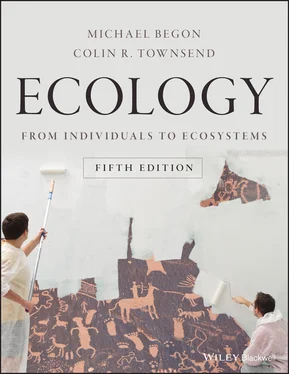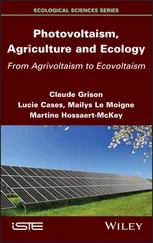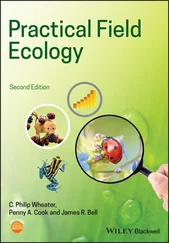4 Chapter 4 Figure 4.1 Modular plants (left) and animals (right) show the underlying par... Figure 4.2 Compilation of patterns of mortality (survivorship) and reproduct... Figure 4.3 The growth of a genet reflects the births and deaths of its compo... Figure 4.4 Integration within a plant leads to a shifting balance of positiv... Figure 4.5 Indices of abundance can provide valuable information. The abunda... Figure 4.6 Schematic life histories for unitary organisms. (a) An outline li... Figure 4.7 The composition of seed banks can be very different from the vege... Figure 4.8 Dormancy in goldenrods is enforced by defoliation. The histories ... Figure 4.9 Derivation of cohort and static life tables. See text for details... Figure 4.10 Representations of the survival of a cohort of the yellow‐bellie... Figure 4.11 Classification of survivorship curves plotting log( l x) against a... Figure 4.12 Distribution of the shapes of survivorship curves for 37 species... Figure 4.13 Static life tables can be informative, especially when alternati... Figure 4.14 Reconstructed static life table for the modules (tillers) of a C... Figure 4.15 Life cycle graphs and population projection matrices for two dif... Figure 4.16 Populations with constant rates of survival and fecundity eventu... Figure 4.17 Elements and outcome of an integral projection model (IPM) for f... Figure 4.18 Analyses of life table response experiments (LTREs) can guide cu... Figure 4.19 Elasticity analyses can guide the management of armadillo abunda... Figure 4.20 Elasticity analysis can guide the management of thistle abundanc...
5 Chapter 5 Figure 5.1 In exploitation competition, resource levels decline as populatio... Figure 5.2 Competition may combine elements of both exploitation and interfe... Figure 5.3 Density‐dependent mortality. (a) Upper panel: the density o... Figure 5.4 Density‐dependent fecundity. (a) The fecundity (seeds per p... Figure 5.5 Density‐dependent growth. The mean length of monarch butter... Figure 5.6 Plants sown at a range of densities often grow to achieve a const... Figure 5.7 The ‘constant final yield’ of plants illustrated by a line of slo... Figure 5.8 Intraspecific competition in plants often regulates the number of... Figure 5.9 Optimal sowing rates can conserve rare weedy plants without threa... Figure 5.10 When modular organisms compete, the modules closest to neighbour... Figure 5.11 The use of k values for describing patterns of density‐dependent... Figure 5.12 Density‐dependent birth and mortality rates lead to the regulati... Figure 5.13 Intraspecific competition typically generates n‐shaped net recru... Figure 5.14 Some dome‐shaped net‐recruitment curves. (a) Six‐mon... Figure 5.15 Real examples of S‐shaped population increase. (a) The bac... Figure 5.16 The global urban population has overtaken its rural counterpart ... Figure 5.17 The global human population grew slowly for millennia but has re... Figure 5.18 The birth and death rates in Europe since 1850. The annual net r... Figure 5.19 What happens to the global human population size depends on futu... Figure 5.20 Mathematical models of population increase. (a) In populations w... Figure 5.21 The intraspecific competition inherent in Equation 5.13. The fin... Figure 5.22 The intraspecific competition inherent in Equation 5.19. The fin... Figure 5.23 The range of population fluctuations generated by Equation5.19. ... Figure 5.24 Populations in stochastic models may have a high chance of going... Figure 5.25 Exponential (solid line) and sigmoidal (dashed line) increase in... Figure 5.26 Intraspecific competition increases the skewing in the distribut... Figure 5.27 Intraspecific competition increases the skewing in the distribut... Figure 5.28 Size inequalities first increase then decrease in competing popu... Figure 5.29 Root and shoot competition can have contrasting effects on mean ... Figure 5.30 Asymmetric competition enhances population size regulation in an... Figure 5.31 The number of (successful) territories may increase at higher re... Figure 5.32 Territory sizes occupied by male lions (Panthera leo) in Zimbabw... Figure 5.33 Older individuals hold the territories in a black kite populatio... Figure 5.34 ‘Dear enemy’ and ‘nasty neighbour’ effects.... Figure 5.35 The importance of good territories for the conservation of beard... Figure 5.36 Crowded plant populations typically approach and then track self... Figure 5.37 Self‐thinning in a wide variety of herbs and trees. Each l... Figure 5.38 The species boundary line for populations of red pine, Pinus dens ... Figure 5.39 Self‐thinning lines vary in their support for the metabolic theo... Figure 5.40 A density management diagram (DMD) for Norway spruce in central‐...
6 Chapter 6 Figure 6.1 The movements of locusts and their impending threat. An example f...Figure 6.2 Variation in physical and biotic variables in the Santuit River, ...Figure 6.3 The optimal location of nature reserves for giant pandas in China...Figure 6.4 The ‘seed rains’ of four tree species from a temperate rainforest...Figure 6.5 Predicting an outbreak of bluetongue virus. Results from the mode...Figure 6.6 Seed dispersal by frugivores can show a variety of patterns. The ...Figure 6.7 Birds and moths reflect contrasting combinations of active and pa...Figure 6.8 Phalanx‐type plants aggregate locally and co‐occur little with ot...Figure 6.9 Three generalised spatial patterns that may be exhibited by organ...Figure 6.10 The ‘grain’ of the environment must be seen from the perspective...Figure 6.11 Group living protects against predation in the chestnut‐crowned ...Figure 6.12 Inbreeding and outbreeding depression in Delphinium nelsonii . (a...Figure 6.13 Kin competition may drive offspring away from their natal habita...Figure 6.14 Density‐dependent emigration in spiders and mites. In labo...Figure 6.15 Plants staying at home in bad years and dispersing in good years...Figure 6.16 Dispersal polymorphisms. (a) The mean proportion (± SE) of winge...Figure 6.17 The proportion of male‐biased as opposed to female‐biased disper...Figure 6.18 The rapid spread of the western corn rootworm, Diabrotica virgif...Figure 6.19 Dispersal drives the local distribution of a sand‐dune plant....Figure 6.20 Flying squirrels in Finland preferentially occupy habitat favour...Figure 6.21 The predictable dispersal of zebra mussels, invading the USA. (a...Figure 6.22 Invasion of the giant hogweed. The changing distribution over ti...Figure 6.23 Butterflies tend to occupy the largest, least isolated habitat p...Figure 6.24 Identifying priority North American butterfly species for conser...Figure 6.25 The spatial structure of a metapopulation affects its overall ab...Figure 6.26 Applications of species distribution modelling. (a) Ecological niche mo...Figure 6.27 Many subpopulations of a bee metapopulation go extinct from year...Figure 6.28 Mainland–island metapopulations of a butterfly with contrasting ...Figure 6.29 A plant metapopulation. (a) Locations of the subpopulations, on ...Figure 6.30 Hanski’s metapopulation of the Glanville fritillary. (a) M...Figure 6.31 Alternative stable states for the Glanville fritillary metapopul...Figure 6.32 Genetic effects on the dynamics of the Glanville fritillary meta...Figure 6.33 Contractions in the ranges of four bird species that have especi...Figure 6.34 The changing distribution of the giant panda in China that will ...
7 Chapter 7Figure 7.1 Studies of selection show a tendency for larger body size to be f...Figure 7.2 Allocations of dry matter and nitrogen to the parts of a plant va...Figure 7.3 Reproductive value generally rises and then falls with age. (a) T...Figure 7.4 Life history trade‐offs demonstrate the costs of reproduction....Figure 7.5 The ‘Y model’ of de Jong and van Noordwijk ( 1992). T...Figure 7.6 Snakes that produced larger litters also recovered quicker from r...Figure 7.7 A trade‐off between growth and survival in sticklebacks. Su...Figure 7.8 Trade‐offs between the number of offspring produced in a clutch b...Figure 7.9 Crop plant species differ in the relative responses of seed numbe...Figure 7.10 Options sets and fitness contours together determining optimal l...Figure 7.11 Optimal life histories in high and low cost of reproduction habi...Figure 7.12 Proposed and observed patterns in reproductive allocation as ind...Figure 7.13 Effects of predation risk on patterns of reproduction in killifi...Figure 7.14 The ‘degree’ of semelparity in the plant Lobelia inflata depends...Figure 7.15 The optimisation of offspring size and number in a clutch or lit...Figure 7.16 Guppies produce fewer, larger offspring in a more highly competi...Figure 7.17 The optimisation of offspring size and number in a clutch or lit...Figure 7.18 Recruitment from great tit, Parus major, nests is highest from n...Figure 7.19 Evidence for an intermediate, Lack clutch (litter) size in lynx,...Figure 7.20 Evidence for r ‐ and K ‐selection in dandelions. Resul...Figure 7.21 A fast–slow continuum explains life history variation in plants,...Figure 7.22 A fast–slow continuum explains life history variation in mammals...Figure 7.23 The fast–slow continuum can help guide conservation priorities i...Figure 7.24 Grime’s CSR triangle as an organising principle for plant life h...Figure 7.25 Grime’s CSR triangle and dark diversity as a guide to conserving...Figure 7.26 Allometric life history relationships, all plotted on log scales...Figure 7.27 Allometric relationships between total clutch volume and body vo...Figure 7.28 Phylogenetic comparative methods, taking account of shared ances...Figure 7.29 Allometry, phylogeny and the fast–slow continuum combine to make...
Читать дальше












